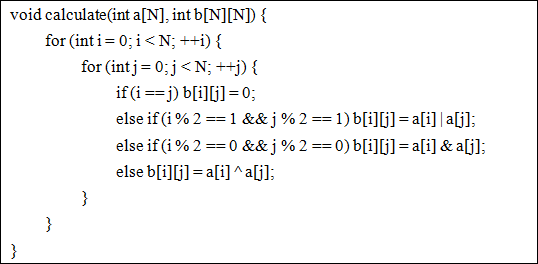Bit Magic
Problem Description
Yesterday, my teacher taught me about bit operators: and (&), or (|), xor (^). I generated a number table a[N], and wrote a program to calculate the matrix table b[N][N] using three kinds of bit operator. I thought my achievement would get teacher's attention.
The key function is the code showed below.

There is no doubt that my teacher raised lots of interests in my work and was surprised to my talented programming skills. After deeply thinking, he came up with another problem: if we have the matrix table b[N][N] at first, can you check whether corresponding number table a[N] exists?
The key function is the code showed below.

There is no doubt that my teacher raised lots of interests in my work and was surprised to my talented programming skills. After deeply thinking, he came up with another problem: if we have the matrix table b[N][N] at first, can you check whether corresponding number table a[N] exists?
Input
There are multiple test cases.
For each test case, the first line contains an integer N, indicating the size of the matrix. (1 <= N <= 500).
The next N lines, each line contains N integers, the jth integer in ith line indicating the element b[i][j] of matrix. (0 <= b[i][j] <= 2 31 - 1)
For each test case, the first line contains an integer N, indicating the size of the matrix. (1 <= N <= 500).
The next N lines, each line contains N integers, the jth integer in ith line indicating the element b[i][j] of matrix. (0 <= b[i][j] <= 2 31 - 1)
Output
For each test case, output "YES" if corresponding number table a[N] exists; otherwise output "NO".
Sample Input
2 0 4 4 0 3 0 1 24 1 0 86 24 86 0
Sample Output
YES NO
Source
Recommend
zhuyuanchen520 | We have carefully selected several similar problems for you: 5061 5060 5059 5058 5057
题目大意:
给你b[i][j],问你a[i]是否冲突?
解题思路:
对于a[i]的每一位依据 d[i][j] 进行2at
解题代码:
#include <iostream>
#include <vector>
#include <cstdio>
#include <algorithm>
using namespace std;
const int maxn=510;
struct edge{
int u,v,next;
edge(int u0=0,int v0=0){
u=u0,v=v0;
}
}e[maxn*maxn*4];
int head[maxn*2],cnt,N;
int dfn[maxn*2],low[maxn*2],color[maxn*2],index,nc;
bool mark[maxn*2];
vector <int> vec;
void adde(int u,int v){
e[cnt]=edge(u,v),e[cnt].next=head[u],head[u]=cnt++;
}
void init(){
vec.clear();
index=nc=cnt=0;
for(int i=0;i<=2*N;i++){
dfn[i]=0;
color[i]=head[i]=-1;
mark[i]=false;
}
}
void tarjan(int s){
dfn[s]=low[s]=++index;
mark[s]=true;
vec.push_back(s);
for(int i=head[s];i!=-1;i=e[i].next){
int d=e[i].v;
if(!dfn[d]){
tarjan(d);
low[s]=min(low[s],low[d]);
}else if(mark[d]){
low[s]=min(low[s],dfn[d]);
}
}
if(low[s]==dfn[s]){
int d;
nc++;
do{
d=vec.back();
vec.pop_back();
color[d]=nc;
mark[d]=false;
}while(s!=d);
}
}
bool sat2(){
for(int i=0;i<2*N;i++){
if(!dfn[i]) tarjan(i);
}
for(int i=0;i<N;i++){
if(color[i]==color[i+N]) return false;
}
return true;
}
int n,b[maxn][maxn];
void build(int x){
N=n;//N =sum point
init();
for(int i=0;i<n;i++){
for(int j=i+1;j<n;j++){
if( i%2==1 && j%2==1 ){//|
if( b[i][j]&(1<<x) ){
adde(i,j+n);
adde(j,i+n);
}else{
adde(i,j);
adde(j,i);
}
}else if( i%2==0 && j%2==0 ){//&
if( b[i][j]&(1<<x) ){
adde(i+n,j+n);
adde(j+n,i+n);
}else{
adde(i+n,j);
adde(j+n,i);
}
}else{//^
if( b[i][j]&(1<<x) ){
adde(i,j+n);
adde(i+n,j);
adde(j,i+n);
adde(j+n,i);
}else{
adde(i,j);
adde(j,i);
adde(i+n,j+n);
adde(j+n,i+n);
}
}
}
}
}
void input(){
for(int i=0;i<n;i++)
for(int j=0;j<n;j++){
scanf("%d",&b[i][j]);
}
}
bool solve(){
for(int i=0;i<n;i++){
if(b[i][i]!=0) return false;
for(int j=i+1;j<n;j++){
if(b[i][j]!=b[j][i]) return false;
}
}
for(int i=0;i<=30;i++){
build(i);
if(!sat2()) return false;
}
return true;
}
int main(){
while(scanf("%d",&n)!=EOF){
input();
if(solve()) printf("YES
");
else printf("NO
");
}
return 0;
}